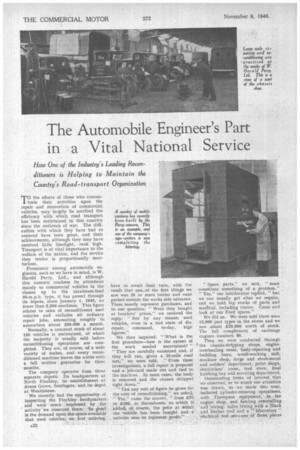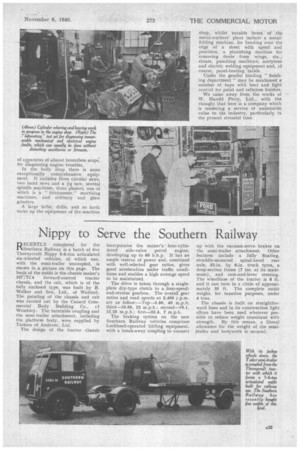The Automobile Engineer's Part in a Vital National Service
Page 24

Page 25

If you've noticed an error in this article please click here to report it so we can fix it.
How One of the Industry's Leading Reconditioners is Helping to Maintain the Country's Road-transport Organization
T0 the efforts of those who concentrate their activities upon the repair and renovation of commercial vehicles, may largely be ascribed the efficiency with which road transport has been maintained in this country since the outbreak of war. The difficulties with which they have had to contend have been great, and their achievements, although they may have received little limelight, rank high. Transport is of vital importance to the welfare of the nation, and the service they render is proportionally meritorious.
Prominent among automobile engineers, such as we have in mind, is W. Harold Perry, Ltd., and although this concern confines its attentions mainly to commercial vehicles in the classes up to the maximum-load 30-m.p.h. type, it has passed through its depots, since January 1, 1940, no fewer than 2,500 machines. This figure relates to sales of reconditioned used vehicles and excludes all ordinary repair jobs, amounting roughly to, somewhere about 200-300 a month.
Normally, a constant stock of about 150 vehicles is maintained, of which the majority is usually sold before reconditioning operations are completed. They are, of course, of a wide variety of makes, and every reconditioned machine leaves the works with a full written guarantee for three months.
The company operates from three separate depots: Its headquarters at North Finchley, its establishment at Amos Grove, Southgate, and its depot at Wealdstone.
We recently had the opportunity ‘).f inspecting the Finchley headquarters and . were much impressed byactivity we observed there. So reat is the demand upon the space-available that used vehicles, on first arriving,
have to await their turn, with the result that one, of the first things we saw was 25 or more lorries and vans parked outside the works side entrance. These mostly represent purchases, and to our question: " Were they bought at breakers' prices," we received the reply: "Not by any means; used vehicles, even in a bad state of disrepair, command, to-day, high figures."
We then inquired: " What is the first procedure—how is the extent of the work needed ascertained? " " They are carefully examined and, if they will run, given a 25-mile road test," we were told. " From these investigations, a. full report is prepared and a job-card made out and tied to the machine. In most. cases, the body is removed and the chassis stripped right down."
Can any sort of figure be given for the cost of reconditioning," we asked. " Yes," came the answer, " from RIO to £160, or thereabouts, to which is adde.d: of courae, the price at which the vehicle. has, been bought and a suitable sum to represent profit." " Spare parts," we said, " must constitute something of a problem." " Yes," our interlocutor replied, " but we can usually get what we require, and we hold big stocks of parts and material, including timber. Come and look at our Ford spares."
We did so. We were told there were 12,000 part types in the stores and we saw about £25,000 worth of stock. The full complement of exchange engines numbers 80.
Then we were conducted through t.the chassis-stripping shops, engineoverhauling room, body-repairing and building bays, wood-working mill, -machine shop, forge and sheet-metal and welders' department, paint shops, electricians' room, tool store, final finishing bay and servicing department.
Outstanding items of interest that we observed, or to which our attention was drawn, as • we made this tour, included bylinder-reboring operations, with Thompson equipment, • in the engine, shop, and bearing remetalling and bdring; Valve truing with a Black and Decker toot and a " laboratory " 'elec-tricaltest set—one of those pieces of apparatus of almost boundless scope-, for diagnosing engine troubles.
In the body shop there is some exceptionally comprehensive equipment. It includes three circular saws, two band saws and a jig saw, several spindle machines, three planers, one of which is a " thicknesser," mortising machines, and ordinary and glass grinders.
A large lathe, drills, and so forth make up the equipment of the machine
shop, whilst notable items of the metal-workers' plant include a metalfolding machine, for bending over the edge of a sheet with speed and precision, a planishing machine for removing dents from wings, etc., shears, punching machines, acetylene and electric welding equipment and, of course, panel-beating .tackle.
Under the general heading " finishing department" may be mentioned a number of bays with heat and light control for paint and cellulose finishes. We came away from the works of W. Harold Perry, Ltd., with the thought that here is a company which is rendering a service of undeniable value to the industry, particularly, in the present stressful time..




















































